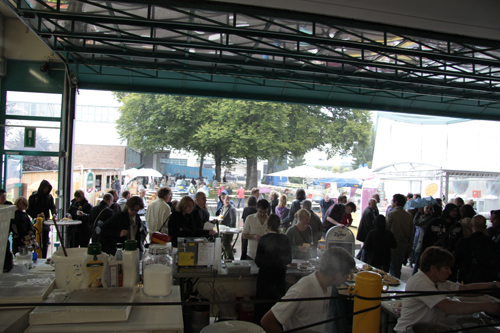my time at ars electronica has been oddly influenced by the book i’m reading. my first proper day strangely resonated with cildo mereiles‘ ideas about circuits and circulation in society – that art can really make a difference in these circuits.
the two main circuits he inserted work into were money (currency) and coca cola distribution, but i had been wondering about what others there were, when i walked into carlo ratti/MIT‘s presentation.
carlo presented two main projects: trash track and sea swarm.
trash track is an older work, based in seattle that seeks to track the removal chain of our consumer products to the same end that the supply chain is tracked (and they don’t like you using their imagery). hundreds of volunteers ‘tracked’ their garbage and ratti presented some stunning video and still visualisations. sadly, when you see these within the wider festival exhibits, you can’t actually find anything more about the products other than a map of where they went. it wasn’t clear (to me at least), whether they were mulched, re-used (like was a paper starbucks cup picked up by a beggar and used to get a bottomless refill?) or taken to a recycling plant, or left to degrade on the streets? perhaps they’re rolling this info out.
but, i think it’s important that this research continues and spreads and gets taken up by as many cities as possible, as an audit of our waste/sanitation circuits. and, it could also be a fantastic tool for some great artforms – manipulating the circuits so that the same cup you threw away ends up on your doorstep every time. or gets redirected to ash keating’s mega installation. or something.
obviously found myself thinking about the use of existing circuits/systems in order to ‘repair’ the environmental, social, financial and philosophical malady of our disposable mindset. and i started with the festival itself.
for the first time, ars electronica was based in a massive, cleared out, ex-industrial space ever-so slightly away from the centre of the city – the old tabakfabric (tobacco factory). aesthetically, acoustically and historically, it was amazing and there was a real ‘collected’ vibe sometimes.
but, in festivals past (when the works were spread between the galleries and spaces throughout the city) we would all eat in existing eateries – paying their staff, using their existing furniture, utensils, toilets, kitchens, systems of disposal/clean-up/supply, use existing public transport modes, discover the smaller details of the city and expand the existing city with people and art.
this time, we hardly went to any of the local cafes or restaurants.
this time, we had special on-site catering (that was mostly expensive and limited), special cutlery/crockery shipped in, disposable beer cups (even with a pfand), extra pop-up kitchens, fridges, kegs and energy supplies, extra portable toilets, extra staff and signage and furniture and lighting.
see where i’m going?
i know that there are different ‘repair’ benefits to a separated, concentrated and contracted ‘festival atmosphere’, but given the discussion about clean-up, technology and all the exhibits about repairing the environment, i couldn’t help but wonder if this festival model itself was not in everyone’s best interest.


